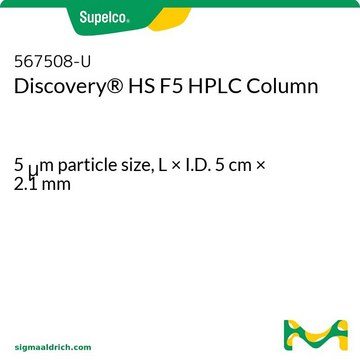567502-U
Discovery® HS F5 (3 µm) HPLC Columns
L × I.D. 10 cm × 2.1 mm, HPLC Column
Synonym(s):
Discovery Pentafluorophenyl PFP HPLC Column
About This Item
Recommended Products
product name
Discovery® HS F5 HPLC Column, 3 μm particle size, L × I.D. 10 cm × 2.1 mm
material
stainless steel column
Quality Level
Agency
suitable for USP L43
product line
Discovery®
feature
endcapped
manufacturer/tradename
Discovery®
packaging
1 ea of
extent of labeling
12% Carbon loading
parameter
≤70 °C temp. range
400 bar pressure (5801 psi)
technique(s)
HPLC: suitable
LC/MS: suitable
L × I.D.
10 cm × 2.1 mm
surface area
300 m2/g
surface coverage
4 μmol/m2
impurities
<10 ppm metals
matrix
silica gel, high purity, spherical particle platform
fully porous particle
matrix active group
PFP (pentafluorophenyl) phase
particle size
3 μm
pore size
120 Å
operating pH range
2-8
application(s)
food and beverages
separation technique
reversed phase
Looking for similar products? Visit Product Comparison Guide
General description
Generally, bases are retained longer on the HS F5 than on a C18. Increasing the organic content of a C18 separation 5 to 10 percent will generally provide similar retention on an HS F5. Results with other compounds are highly variable. However, it is generally true that solutes with log Po/w values less than 2.5 will be retained longer on HS F5 compared to a C18. The degree of difference is highly solute dependent.
Application
- Optimization and validation of a bioanalytical HPLC-UV technique for simultaneous determination of underivatized phenylalanine and tyrosine in the blood for phenylketonuria diagnosis and monitoring.: This study optimizes and validates an HPLC-UV method using a Discovery® HS F5 HPLC Column for the simultaneous determination of phenylalanine and tyrosine in blood samples, providing a robust tool for diagnosing and monitoring phenylketonuria. (Rabti et al., 2024).
- Heart-cut bidimensional achiral-chiral liquid chromatography applied to the evaluation of stereoselective metabolism, in vivo biological activity, and brain response to chiral drug candidates targeting the central nervous system.: The study uses the Discovery® HS F5 HPLC Column in a bidimensional achiral-chiral liquid chromatography setup to evaluate the stereoselective metabolism and biological activity of chiral CNS drug candidates. (Battisti et al., 2016).
- Chromatographic separation of arsenic species with pentafluorophenyl column and application to rice.: This paper describes the separation of arsenic species in rice using a pentafluorophenyl column, highlighting the effectiveness of the Discovery® HS F5 HPLC Column for environmental and food safety applications. (Baba et al., 2014).
- Advantages of pentafluorophenylpropyl stationary phase over conventional C18 stationary phase--application to analysis of triamcinolone acetonide.: The research compares the Discovery® HS F5 HPLC Column to conventional C18 columns, demonstrating superior performance in the analysis of triamcinolone acetonide. (Havlíková et al., 2008).
Features and Benefits
- Unique selectivity
- Similar retention to C18 (sometimes requires stronger mobile phase)
- Excellent peak shape
- Stable, low-bleed LC-MS separations
- Scalable separations from 3 to 10μm particle sizes
Legal Information
Not finding the right product?
Try our Product Selector Tool.
guard cartridge
Storage Class Code
13 - Non Combustible Solids
WGK
WGK 3
Flash Point(F)
Not applicable
Flash Point(C)
Not applicable
Choose from one of the most recent versions:
Already Own This Product?
Find documentation for the products that you have recently purchased in the Document Library.
Our team of scientists has experience in all areas of research including Life Science, Material Science, Chemical Synthesis, Chromatography, Analytical and many others.
Contact Technical Service